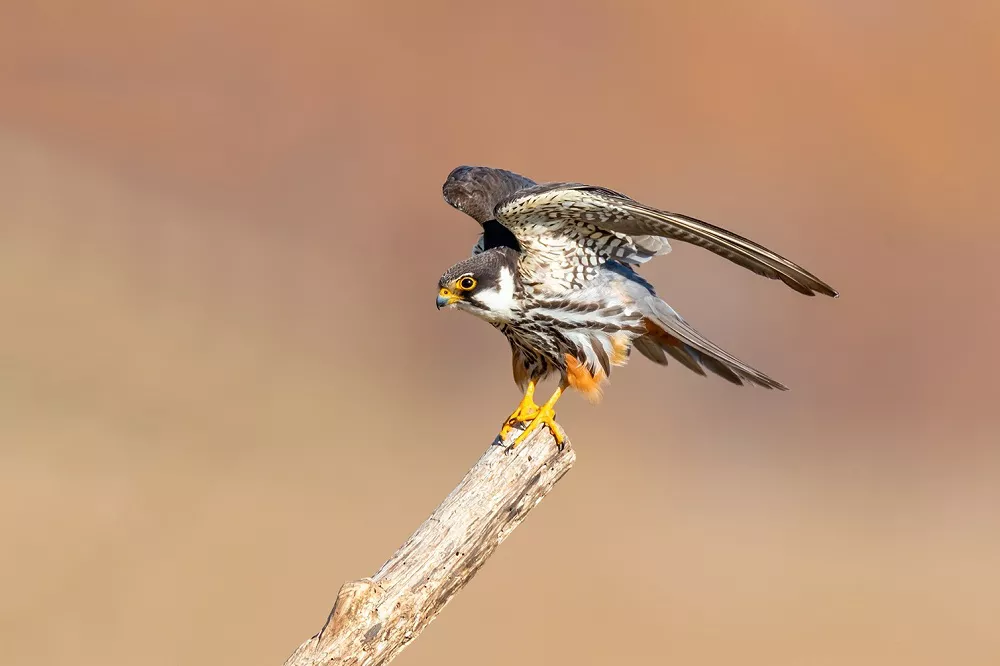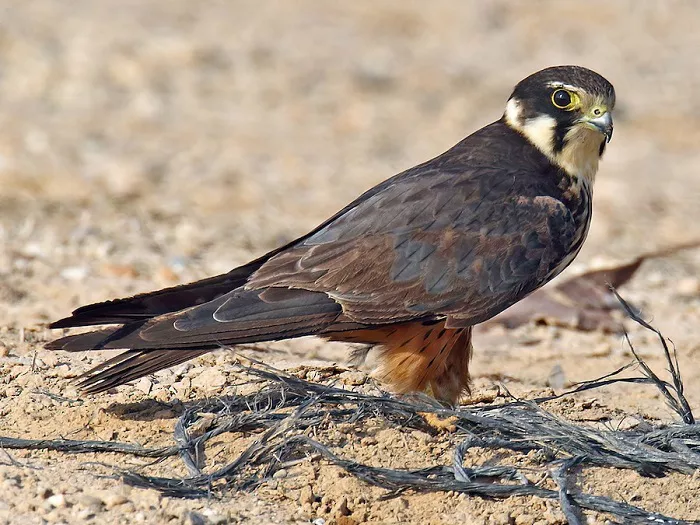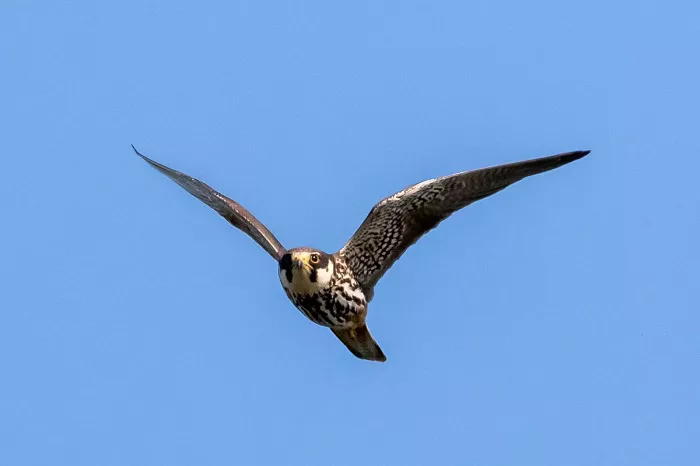The Eurasian Hobby (Falco subbuteo) is a small, agile falcon known for its remarkable speed and aerial acrobatics. This bird of prey is found across Europe, Asia, and parts of Africa. Despite its widespread presence, the Eurasian Hobby faces challenges that threaten its population, particularly due to the abundance of food resources being affected. The population trend of the Eurasian hobby appears to be decreasing in some regions due to habitat loss. Understanding its behavior, habitat, and the threats it faces is crucial for its conservation.
What does Eurasian hobby look like
The Eurasian Hobby is a fast flying bird of prey, known for its agility and speed in flight, making it one of the most fascinating fast flying falcons in the world. The Eurasian hobby has a body length of about 36 cm, a wingspan of 68-84 cm, and a weight of 140-340 grams. Smaller than Saker Falcon, Peregrine Falcon, etc., it is a small raptor. The beak is shorter than that of hawks, with tooth processes on both sides of the apex, and the base is not covered with cereus or whisker feathers; the nostrils are round, and a columnar bony stick can be seen inward from the nostrils; the wings are long and narrow, and the flapping rhythm is fast ; The tail is slender. The wings are narrow and pointed.
The upper body of the male bird is red brick, with black triangular spots on the back and wings; the top of the head, the back of the neck, and the side of the neck are blue-gray. The flight feathers are nearly black, with off-white feather ends; the tail feathers are blue-gray, with broad black sub-terminal spots, and the feather ends are off-white. The lower body is milky yellow with light brown, with dark brown feathers and rough spots. Mouth base blue-yellow, tip gray. Feet dark yellow.
The upper body of the female bird is dark brown, mixed with dark brown horizontal spots; the top of the head and the back of the neck are light brown, with dark brown feathers; the tail feathers are dark brown, with 9-12 dark brown horizontal spots.
Juvenile birds are similar to female birds, but with heavier longitudinal stripes. The difference from the yellow-clawed falcon is that the tail is round, the body is larger, and it has mustache lines. The male bird has spots on the back, more vertical lines on the lower body, and lighter cheeks.
Easy identification: there are eye spots under the eyes, and dark spots on the back. There are dark spots on the chest. Hover while flying. Female birds are larger than males. Some males and females are the same length. The body is slender. Mouth claws smaller than females.
When the wings are folded, the tips of the wings almost reach the end of the tail feathers, which looks a lot like a swallow, hence the name. The iris is dark brown, the eye area and cere are yellow, the mouth is blue-gray, the tip is black, the feet and toes are yellow, and the claws are black.
Flight and Speed
The Eurasian Hobby is renowned for its speed and agility. In level flight, it can reach speeds up to 100 km/h (62 mph), and during a stoop or dive, it can exceed 160 km/h (99 mph). Its flight is characterized by rapid wingbeats followed by glides, allowing it to maneuver swiftly through the air, where prey is often caught mid-flight. This agile predator eats a variety of flying prey, including birds and large insects.
Habitat and Distribution
Preferred Habitats
Eurasian Hobbies inhabit open landscapes with scattered trees, such as farmland, marshes, savannahs, taiga, and open woodland. They are also found in lowland areas with small woodlands and even urban parks. They typically inhabit regions near rivers or wetlands, indicating a preference for open areas adjacent to these waterways. Agricultural intensification poses a threat to the Eurasian hobby through the removal of nesting trees and reduction of prey availability. These habitats provide ample hunting grounds and suitable nesting sites.
Geographic Range
This species has a vast range, breeding across Europe, Asia, and the Middle East, and migrating to sub-Saharan Africa and southern Asia for the winter. In the UK, the Eurasian Hobby is a summer visitor, arriving in late March and departing by October. In China, they migrate to breeding grounds in Northeast China in mid to late April and leave between late September and early October.
Eurasian Hobby Hunting Techniques
The Eurasian Hobby is a master of speed and agility, often employing a technique known as “aerial hawking,” where they catch prey mid-flight. They are most active during dawn and dusk, times when insects such as dragonflies and beetles are active. Eurasian Hobbies have excellent vision, allowing them to spot and capture prey with precision. Their catch is often eaten while still in flight, showcasing their remarkable hunting skills.
Eurasian Hobby Diet
The Eurasian Hobby’s diet consists mainly of small birds and flying insects. It feeds on birds such as larks, martins, swifts, finches, sparrows, and other fast flying birds. Insects like dragonflies, moths, and locusts are also common prey. Occasionally, it may catch bats or small mammals. Their diet varies seasonally, with more birds taken during the breeding season and insects during migration. The Eurasian hobby’s sharp beak and talons are crucial for its hunting prowess.
Breeding and Nesting
Nesting Habits
Eurasian Hobbies do not build their own nests. Instead, they reuse old nests built by other birds, such as crows and magpies. These nests are typically located high in trees, often at the edge of woodlands or in isolated trees in open areas.
Breeding Season
The breeding season begins in May or June. During courtship, males perform aerial displays and present food to females. The female lays 2–4 eggs, which are incubated for about 24–28 days, primarily by the female, while the male provides food. After hatching, both parents feed the chicks, which fledge after 28–34 days but remain dependent on their parents for several more weeks.
Migration Patterns
Eurasian Hobbies are migratory birds. They breed in Europe and Asia and migrate to Africa and southern Asia for the winter. Migration occurs in small groups, and they travel thousands of kilometers between breeding and wintering grounds. Shooting is a significant cause of mortality for the Eurasian hobby during migration, especially in Malta. In the UK, they arrive from late March onwards and start to depart from late August, with most having left by October.
Wintering Grounds
The Eurasian Hobby migrates to Africa for the winter, with some populations traveling considerable distances to reach their wintering grounds. These habitats, which include open country, grasslands, and marshes, are rich in insects and small birds, providing essential food sources for the species. The wintering grounds are crucial for the survival of the Eurasian Hobby, and conservation efforts should focus on protecting these areas to ensure the long-term survival of the species.
Lifespan and Population
In the wild, Eurasian Hobbies typically live between 10 to 14 years. They occur in small numbers and low population densities across their vast range. The global population of Eurasian Hobbies is estimated to be between 900,000 and 1,500,000 mature individuals, but hunters contribute to their mortality, particularly during migration periods. In Europe, the population is considered stable, with an estimated 140,000–219,000 pairs. However, the cutting of old growth forest patches in Ukraine is thought to have caused local declines in Eurasian hobby populations.
Conservation Status
The Eurasian hobby is categorized as Least Concern by the IUCN Red List. Eurasian Hobbies are listed in CITES Appendix II and CMS Appendix II, providing them with international protection. Breeding schemes are in place in at least 13 European countries to monitor and support populations.
Conclusion
The Eurasian Hobby is an extraordinary bird of prey, known for its agility, speed, and remarkable hunting skills. Its adaptability to various habitats and its role in maintaining ecological balance make it a fascinating species to study and observe. As we continue to learn more about this bird and its place among the birds of the world, it is crucial to ensure the preservation of its natural habitats to safeguard its future.





 Facebook
Facebook  Instagram
Instagram  Youtube
Youtube 